Cycnium racemosum
Cycnium racemosum Benth.
Family: Orobanchaceae
Common names: large pink ink plant, large mountain ink flower, large pink mushroom flower (Eng.); berginkplant (Afr.); injanga (isiXhosa); uhlabahlangane (isiZulu)
Introduction
An attractive mountain plant found in grassland on rocky outcrops, with large fragrant pink flowers in summer to early winter. Flowers turn black when bruised, damaged or dried, which is common in many plants of this family.
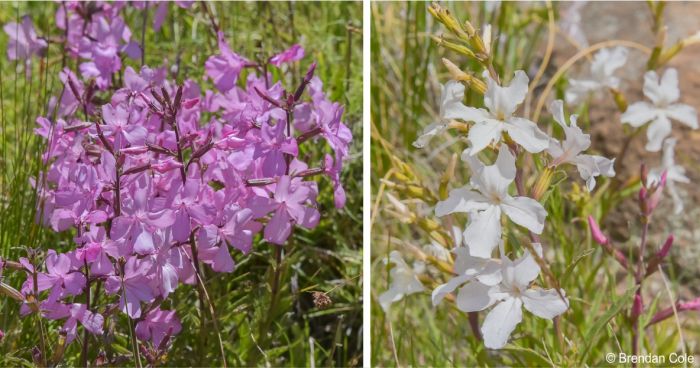
Description
Description
Cycnium racemosum is a perennial hemiparasitic herb that can grow up to 0.8 m tall. The stem is erect. Leaves are hairy, narrow, opposite and have a purplish-red, toothed margin. The large, fragile flowers are either white or pink, with 5 sepals fused into a tubular calyx about 12 mm long, and the corolla up to 60 mm wide with a tube about 25 mm long. The flowers occur in many-flowered racemes, from summer to early winter (Nov.-Jun.). The fruits are oval capsules, enclosed by the calyx.
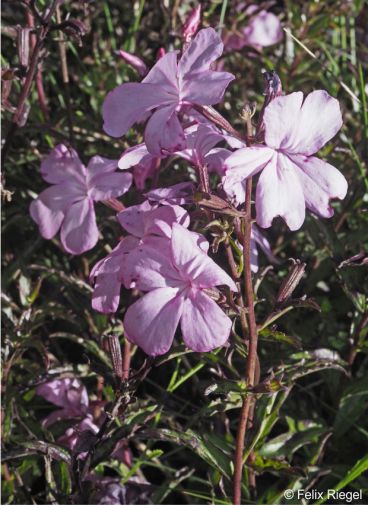
Conservation Status
Status
According to the Red List of South African plants, the conservation status of Cycnium racemosum is assessed as Least Concern (LC), meaning it is not under threat in its natural habitat.
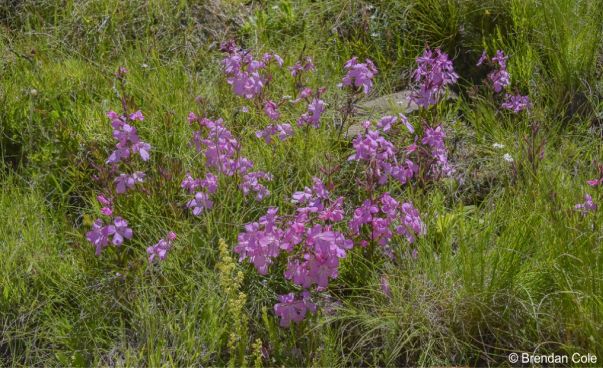
Distribution and habitat
Distribution description
Cycnium racemosum grows in open or semi-shaded grasslands and fynbos, on mountain slopes, reaching altitudes of up to about 2 600 m, in the eastern parts of South Africa, in the Eastern Cape, Free State, KwaZulu-Natal, Limpopo and Mpumalanga Provinces, and in Lesotho and Eswatini. The habitat is summer-rainfall grassland.
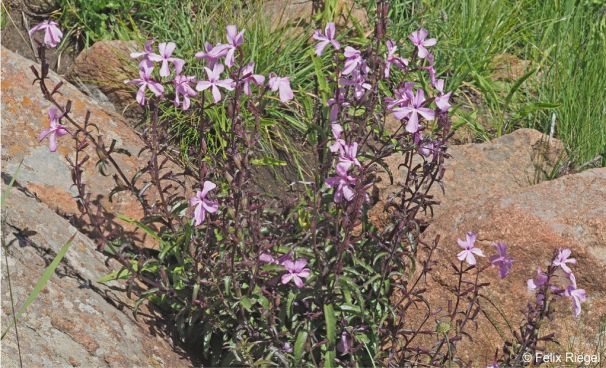
Derivation of name and historical aspects
History
The name Cycnium is derived from the Greek kyknos meaning ‘swan’ and refers to the slender, elongated corolla tube that resembles a swan's neck. The species name racemosum meaning ‘with flowers in a raceme’, refers to the clustered flowers; a raceme being an elongated inflorescence with the youngest flowers at the top. In the olden days, Cycnium racemosum was used to make a substitute for writing ink, as they were able to produce an ink-like substance from the flowers that turn black when dry, which gave them their common name ink flower or ink plant. It is also called mushroom flower as it flowers in mushroom season.
Cycnium belongs in the Orobanchaceae, a family of annual or perennial herbs and shrubs that are either hemiparasites (partial parasites like Cycnium) or holoparasites (total parasites that depend on the host for both inorganic and organic compounds). Members of this family occur in the temperate regions of the world, including South Africa. The family contains 90 genera with 15 genera represented in South Africa, including these species that are also featured on PlantZAfrica: Graderia scabra (wild penstemon), Harveya squamosa (ink flower) and Hyobanche fulleri (cat nails).
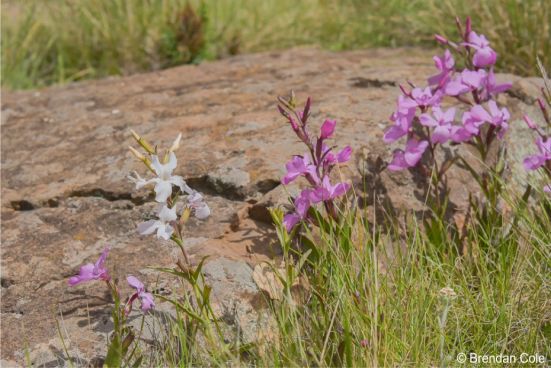
Ecology
Ecology
Hemiparasites, sometimes called semi-parasites, are plants that partly depend on a host plant from which it receives the inorganic components, such as water and minerals, but it has green leaves and can acquire carbon dioxide, and its leaves are thus able to produce organic materials by photosynthesis. The likely neighbours of Cycnium racemosum plants are grasses and sedges, and the roots simply grow an attachment to a nearby grassy plant and thereby can tap its resources.
Pollinators of the majority of the species in this genus include flies and moths such as the Hawkmoths, Hippotion celerio and Nephele comma.
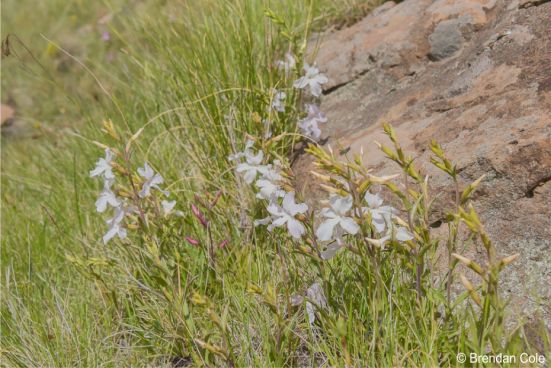
Uses
Use
The plant is used traditionally as an emetic to treat pain, and to ease childbirth. The Zulu people use smoke from burning leaves as fumigation to pass over animals to be slaughtered during ritual sacrifices.
Growing Cycnium racemosum
Grow
This plant species is hemiparasitic and cannot be cultivated in the absence of their host plants, since it derives water and nutrients from the host. To grow this plant one would have to know which plants it uses as a host, and to first grow a host plant and allow it to become established, and then to sow its seeds close to this host plant. The seedling has to connect with the host’s roots soon after germination if it is to survive.
References
- Cole, B. 2019. Observation of Cycnium racemosum, Glen Lynden Farm, Naude's Neck, Eastern Cape, South Africa. iNaturalist. Online. https://www.inaturalist.org/observations/19572754.
- Cole, B. 2019. Observation of Cycnium racemosum, Glen Lynden Farm, Naude's Neck, Eastern Cape, South Africa. iNaturalist. Online. https://www.inaturalist.org/observations/36964512.
- Hutchings, A., Scott, A.H., Lewis, G. & Cunningham, A.B. 1996. Zulu medicinal plants: an inventory. University of Natal Press, Pietermaritzburg.
- Koekemoer, M., Steyn, H.M. & Bester, S.P. 2015. Guide to Plant Families of southern Africa. Strelitzia 31. 2nd ed., 2nd print. South African National Biodiversity Institute, Pretoria, South Africa.
- Manning, J. 2001. Eastern Cape wild flower guide. Botanical Society of South Africa, Cape Town.
- Manning, J. 2009. Field guide to wild flowers of South Africa. Struik Nature, Cape Town.
- Mofokeng, T. 2020. Graderia scabra (L.f.) Benth. (Orobanchaceae). PlantZAfrica. Online. http://pza.sanbi.org/graderia-scabra.
- Pearse, R.O. 1978. Mountain splendour. Wild flowers of the Drakensberg. Howard Timmins, Cape Town.
- Pooley, E. 1998. A field guide to wild flowers Kwazulu-Natal and the eastern region. Natal Flora Publications Trust, Durban.
- Raimondo, D., Von Staden, L., Foden, W., Victor, J.E., Helme, N.A., Turner, R.C., Kamundi, D.A. & Manyama, P.A. (eds) 2009. Red list of South African plants. Strelitzia 25. South African National Biodiversity Institute, Pretoria.
- Retief, E. & Meyer, N.L. 2017. Plants of the Free State inventory and identification guide. Strelitzia 38. South African National Biodiversity Institute, Pretoria.
- Riegel, F. 2022. Observation of Cycnium racemosum, Platberg, Harrismith, Free State, South Africa. iNaturalist. Online. https://www.inaturalist.org/observations/139727183.
- Schroter, A. 1987. Some new plants for Lesotho. Veld & Flora 73(2):48-49.
- Wikipedia. Cycnium tubulosum. https://en.wikipedia.org/wiki/Cycnium_tubulosum. Accessed 2024/01/25.
Credits
Lufuno Nenungwi and Amahle Mbali Shelembe
Free State National Botanical Garden
April 2024
Acknowledgements: images by Brendan Cole and Felix Riegel.
Plant Attributes:
Plant Type: Parasitic, Perennial
SA Distribution: Eastern Cape, Free State, KwaZulu-Natal
Soil type: Sandy, Loam
Flowering season: Early Summer, Late Summer, Autumn
PH: Acid, Neutral
Flower colour: White, Pink
Aspect: Full Sun
Gardening skill: Challenging
Special Features:
Horticultural zones









Rate this article
Article well written and informative
Rate this plant
Is this an interesting plant?
Login to add your Comment
Back to topNot registered yet? Click here to register.